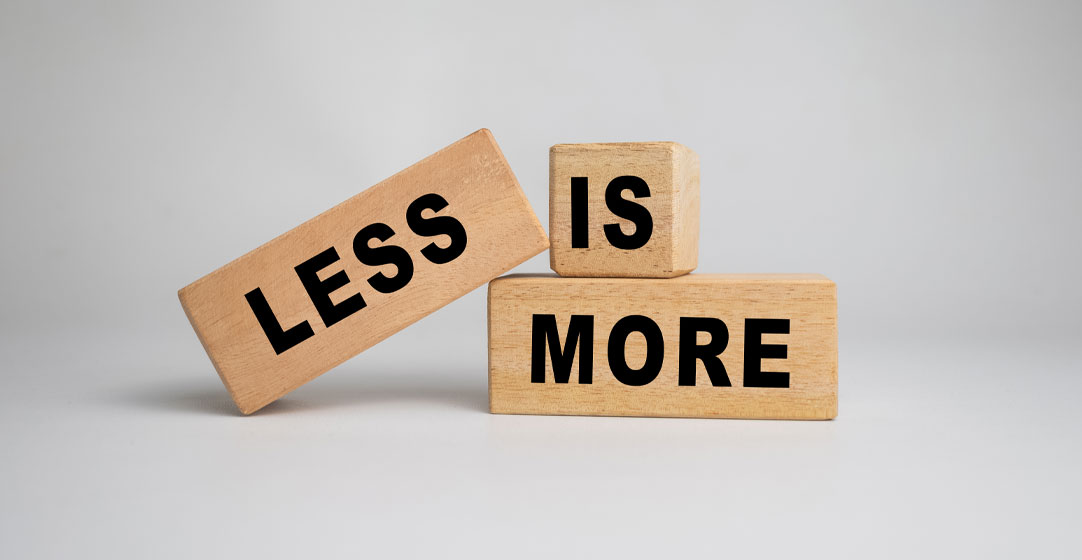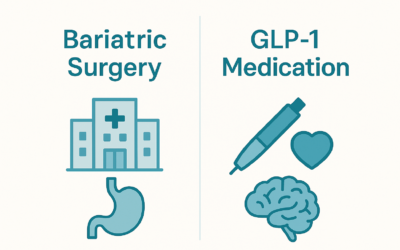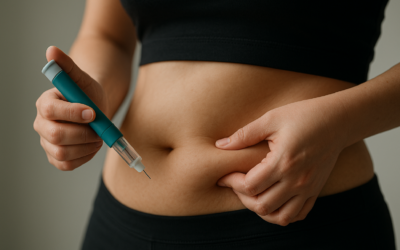Forget the ‘one-size-fits-all’ approach — microdosing GLP-1 injectables lets you take control of your treatment.
When it comes to weight loss medications, there’s growing buzz around microdosing GLP-1 injectables. Some swear by it, claiming it offers better control, fewer side effects, and steadier progress. Others dismiss it as a fad, arguing there’s not enough hard data to back it up. So, what exactly is microdosing when it comes to GLP-1 injectables? And is it something you should consider doing? Let’s take a look.
Microdosing GLP-1 injectables: What it is and why it matters
Microdosing GLP-1 injectables means taking smaller, more frequent doses rather than following the standard treatment schedule. Traditional GLP-1 medications — like Ozempic or Wegovy — come with fixed dosing recommendations, usually in set increments like 0.25 mg, 0.5 mg, or 1 mg. Microdosing, on the other hand, is all about finding a dose that feels right for you, even if that means starting much lower than standard guidance suggests.
Instead of immediately jumping to the prescribed starting dose, you might begin with just 0.10 mg and gradually work your way up. Or you might find that smaller, more frequent doses fit better with your lifestyle and reduce common side effects like nausea or fatigue. The goal isn’t to take less medication just for the sake of it — it’s to create a personalized approach that minimizes discomfort and helps you stay on track.
Why consider microdosing? Because it puts you in control. By giving yourself more flexibility to adjust your dose based on how you’re feeling and what’s working, you gain the freedom to fine-tune your treatment plan without feeling boxed in by rigid guidelines.
Microdosing GLP-1 injectables puts you in control
When it comes to flexibility and individualization, microdosing GLP-1 medications is a whole different game compared to standard, fixed-dose treatments. While the traditional dosing approach does offer simplicity, it can also feel rigid, leaving you stuck between choosing a dosage that might feel too strong or too weak, with little room for adjustment or for fine-tuning your medication schedule to suit your unique body.
Microdosing flips that script entirely. Rather than forcing everyone onto the same dosing schedule, it opens the door to a genuinely personalized approach. Maybe your body responds better if you start at a very small dose — say 0.10 mg rather than jumping straight into the standard 0.25 mg dose of Ozempic. This smaller increment gives your body a gentler entry point, allowing you to ease into the medication, minimizing potential side effects like nausea or gastrointestinal discomfort. Then, as you see how your body reacts, you and your healthcare provider can carefully dial the dose up or down based on your experience, making it easier to maintain consistent progress without unnecessary discomfort.
The beauty of microdosing is how it adapts to real life. Let’s say you’re going through a stressful phase, and your hunger signals go haywire. Instead of sticking rigidly to a higher dose or, worse, abandoning treatment altogether, microdosing lets you gently adjust upward until you regain balance. Or maybe you’re hitting a comfortable stride — your diet is better, your exercise routine is kicking in, and you feel good at a lower dose. With microdosing, you have the freedom to scale back the medication accordingly, minimizing potential side effects without sacrificing your progress.
Beyond dosage adjustments, microdosing also gives you more control over pacing. While standard dosing schedules — like weekly injections — can be convenient, some individuals find smaller, more frequent doses fit more smoothly into their lives and reduce side effects. That kind of flexibility can make the difference between sticking with treatment long-term and giving up early due to discomfort or inconvenience.
And let’s face it, not everyone wants or needs dramatic weight loss right away. Microdosing lets you target specific, realistic goals at your own speed, whether you’re aiming for subtle, steady progress or tackling more significant weight-loss milestones in phases. It puts you — not the medication — in the driver’s seat, tailoring treatment to your preferences, comfort, and lifestyle.
In short, microdosing isn’t just about flexibility; it’s about empowerment. It turns what could be a one-size-fits-all prescription into something more nuanced, more practical, and ultimately more effective, because it’s built around you — your body, your goals, and your everyday reality.
Is there any real reason not to microdose GLP-1 injectables?
Let’s tackle the hesitation head-on: yes, there’s some controversy around microdosing GLP-1 injectables, but most of that controversy comes from caution rather than clear evidence of risk. If you’re already taking GLP-1 injectables specifically for weight loss, lowering your dose shouldn’t be a red flag — it should be exactly the opposite. After all, if higher doses have already proven safe enough to gain FDA approval, how could using less possibly pose a bigger risk?
Still, you’ll hear medical professionals raise concerns about safety, largely because microdosing hasn’t yet been extensively studied in large-scale clinical trials. But double-blind, placebo-controlled trials aren’t always the be-all, end-all in real life. People are already microdosing, and either the weight comes off or it doesn’t — the scale doesn’t lie. If your body responds positively at a lower dose, there’s little practical reason to worry.
And here’s another practical truth: if side effects were a concern at higher doses, microdosing may even reduce those risks. Less medication typically means fewer or less intense side effects. Plus, it’s flexible: you can always adjust upward again if you’re not seeing the results you want. There’s no irreversible commitment — you’re simply finding your personal sweet spot.
However — and this is a big “however” — if you’re using GLP-1 medications to manage diabetes, or if you’re taking them primarily for weight loss but you’re also diabetic or pre-diabetic, microdosing becomes a whole different conversation. Reducing your dose could affect blood sugar management, and that’s not something to take lightly. In these cases, it’s essential you have a clear, honest conversation with your doctor first.
But for weight loss alone, the worst-case scenario is straightforward: if microdosing doesn’t deliver the results you hoped for, you can always readjust. Under medical supervision, you have the flexibility to dial your dosage back up. The power here is in your hands, and the real risk is minimal, especially compared to sticking to unnecessarily higher doses that may not serve you as well.
In the end, the controversy mostly comes down to tradition and cautious medical practice, rather than real-world evidence of risk. For many, microdosing GLP-1 injectables makes perfect sense — giving you greater control without sacrificing results or safety.
Getting started with microdosing GLP-1 injectables
If you’re already on a GLP-1 injectable for weight loss and you’re intrigued by microdosing, getting started is pretty straightforward — no complicated hoops to jump through. The first step, naturally, is to have a conversation with whoever prescribed your medication. Sure, you might encounter some raised eyebrows or hesitation, especially if your provider is cautious by nature, but explaining your reasoning can smooth the way.
Next, it’s about gently dialing back your dose. Microdosing isn’t about making drastic cuts — it’s a careful process of scaling back incrementally and paying close attention to how your body responds. If you’ve been on a standard dose like 1 mg or more, your provider may recommend starting by cutting that dose in half or reducing it in smaller steps over a few weeks. The key is to go slow and steady — rushing the process can make it harder to pinpoint what works best for you.
Tracking your progress is crucial. Watch how your body responds — keep an eye on your weight, appetite, energy levels, mood, and overall comfort. These markers will tell you if you’re on track or if your dose needs further adjustment. Sharing those details with your healthcare provider can help you stay confident that you’re heading in the right direction.
If you find your dose is too low — if your weight loss slows or your appetite creeps back up — it’s easy enough to adjust upward again with your provider’s guidance. The beauty of microdosing is that it’s flexible. With thoughtful adjustments and consistent tracking, you can fine-tune your dose to find the right balance between progress and comfort.
Finding your balance with microdosing GLP-1 injectables
Microdosing GLP-1 injectables is all about flexibility, control, and creating a treatment plan that fits you. By easing into your medication, tracking how your body responds, and making thoughtful adjustments, you can stay on track without feeling stuck in a rigid dosing structure. Whether you’re aiming for gentler progress, better side-effect management, or just want to feel more in control of your journey, microdosing puts the power in your hands. With patience and a little trial and error, you can find the dose that keeps you feeling your best — and still moving toward your goals. Learn more about Claya’s weight loss treatment programs for medically supervised weight loss.



